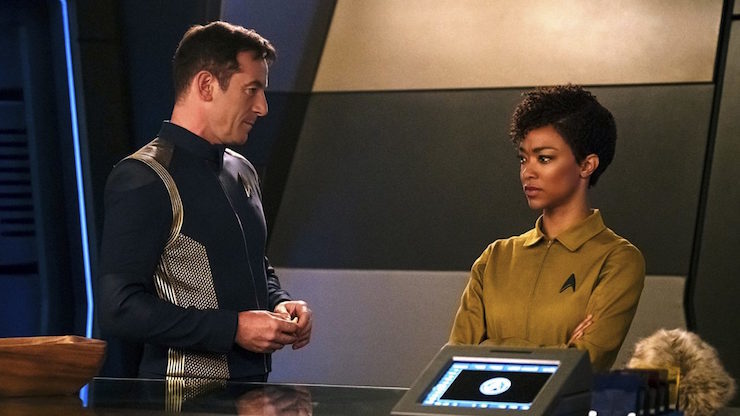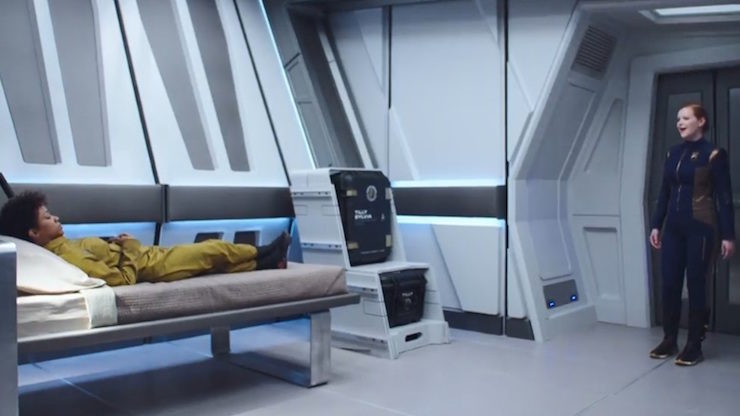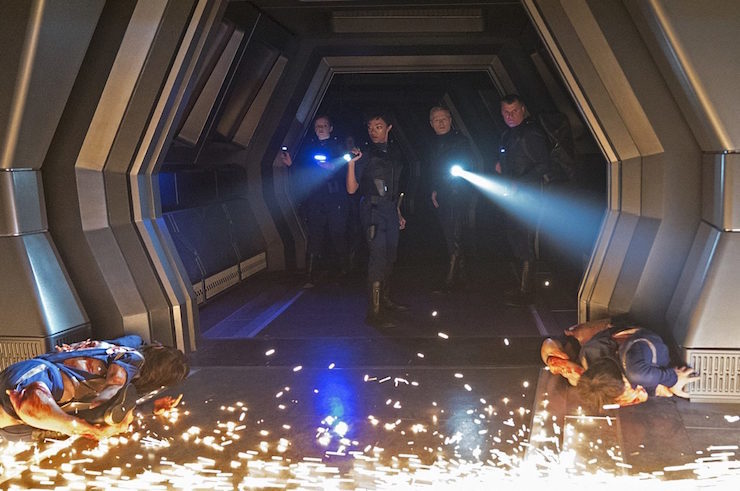By the time I got to the end of “Context is for Kings,” I turned to my wife and said, “This should’ve been the first episode they aired.” It’s the perfect pilot: the bulk of the main cast is introduced, we see the ship for which the show is named, we know that we’re in a war and that Burnham is responsible. I’m not usually the biggest fan of flashbacks, but the general awkwardness and flaws in the two-part premiere would’ve been much easier to take as the fourth or fifth episode, filling in the gaps of what gets mentioned in the script for what is instead the third episode. We get more than enough to be intriguing, and I’m a lot more excited about the show now than I was a week ago.
This is frustrating only because we had to wait a week for it. I’ve been an editor for my entire adult life, going back to college, in fact, and the most common editorial note I have ever given in the three decades I’ve been doing this has been: “lop off the beginning, the story actually starts on page 10 (or wherever).” So often—and as a writer, I’ve done this, too—the first chapter of the book, the first few pages of the story, are a waste of time that spin wheels and provide exposition, while the actual story starts later.
“Context is for Kings” is where Discovery’s story starts.
There’s a lot to parse in this episode, but what I like best is that this episode feels like Star Trek. Yes, there’s a war on, but the U.S.S. Discovery is a science ship, one that we’re told is capable of working on three hundred different scientific projects at once. We only actually see two of them, but Discovery’s job is to do science, and I’m thrilled at the possibilities. Yes, currently, the science is turning its attention toward the war with the Klingons that started last week, but we know this war won’t last forever—probably not past the end of the first season—and Discovery’s mission statement lends itself to all kinds of possible stories, many of which fit right in with the whole boldly going where no one has gone before motif that I hear is a thing in the Trek universe… (ahem)
It’s also different in that our POV isn’t at the top. One of the most well-regarded episodes of Star Trek: The Next Generation was “Lower Decks,” which told its story of a covert mission involving Cardassians from the perspective of the nurse and a bunch of ensigns. It was a nice change of pace, and it’s one that Discovery is also embracing. Burnham is the lowest of the low, a disgraced officer stripped of all rank who is being brought in by Lorca, and is only being told things when absolutely necessary (and not always then). This will likely continue, especially since the person she’ll be talking most to is her roommate, a cadet on a field assignment, who isn’t likely to know much more than her due to her own low-ranking status.
Lorca himself is an interesting character, one with his own agenda that will presumably unfold over the course of the season. Jason Isaacs plays him with a magnificent combination of charm and smarm (Isaacs’s two best modes). It’s also wonderful to see Doug Jones’s Saru back, now as Discovery’s first officer. He gets to be a regular twisting of the knife into Burnham’s gut, a constant reminder of her disgrace. Jones also does a superb job of conveying the character’s compassion and disappointment. More of the supporting cast is introduced, including the always-welcome Rekha Sharma as Security Chief Landry and the intense Anthony Rapp as Stamets, who obviously would be much better suited to Discovery in times of peace, but who has been forced into a more military situation than he’s comfortable with. I particularly love how Rapp plays Stamets’s scientific curiosity, melded with his total disgust with being made to be part of a war effort. I’m taking a wait-and-see attitude on Mary Wiseman’s Cadet Tilly, who is a bit too much of the “hey, we need a quirky nerdy character who’s kind of awkward and can be funny,” and the strings are showing. Hopefully Wiseman can transcend the obviousness of the role.
But the star of the show remains Sonequa Martin-Green, who absolutely nails it. Her subtle facial expressions serve her beautifully here. You know she’s in eighteen kinds of pain, but the pain only really burbles to the surface when she’s with Saru, the one person she can’t keep the Vulcan-training mask on for. She doesn’t want to redeem herself, because she thinks what she did was irredeemable. She just wants to serve out her sentence and be miserable, and maybe get knifed in the yard or something. (At least she does defend herself when her fellow convicts jump her in the mess hall.) Instead, she’s being forced into a shot at redemption—or at least that’s what Lorca says he’s promising. The final scene, where we find out that the creature that murdered the crew of the Glenn and also a Klingon boarding party is now on Discovery, shows that Lorca’s agenda is more complicated. (Not to mention that there are 298 other experiments floating around that we don’t know anything about.)
Two issues I had with in the first two episodes remain major problems here. One is that there really is nothing that requires this to take place prior to the original series and a whole heckuva lot that would make much more sense taking place long after the 24th-century spinoffs. The new technology, the melding of biology and physics that Stamets went on about, the funky spores that Lorca covered Burnham in—this is all stuff that has to fail to work or be super-duper-ultra-classified. We’ve gotten a century and a quarter of story time that follows this series, including thirty seasons’ worth of TV shows and more than a dozen movies, and there was never even the slightest hint of this biotech. And it’s not like better methods of propulsion weren’t being explored beyond the already-established warp drive, what with soliton waves, folding space, slipstream drive, transwarp, etc.
Also can they for crying out loud turn the lights up? I’m amused that they established that Lorca is sensitive to bright lights, but that excuse for keeping the room dark only applies to his ready room. It doesn’t explain why the Shenzhou was so dark last week, or why they had to keep the Glenn so damn dark, either. (Yes, I know the power was out, but you know what? The power was out in the Constellation in “The Doomsday Machine” and the Tsiolkovsky in “The Naked Now” and the Jenolen in “Relics,” and we could still see what was happening on them.)
And, sadly, we’ve got another Star Trek series that’s suffering from redshirt syndrome, where if you don’t get a speaking part, nobody gives a fuck if you die. Did Discovery actually manage to rescue the pilot of the prison shuttle after her tether broke? Or did they just rescue the prisoners so Lorca could get his hands on Burnham, and screw the working stiff who was trying to fix the damn ship? And what about the security guard on the Glenn who got chomped by the monster? Did he have a name? Admittedly, Landry doesn’t seem to care about anyone, but you’d think the guy under her command would at least get a mention after he becomes monster food.
Still, this is a promising start to a fascinating series. Frustrating that it’s the third episode, but done is done. This episode has a tight script, with exposition reduced to a merciful minimum—and when we do get it, from Stamets and from Lorca, it’s full of a sense of wonder that’s very Trekkish—and with a couple of original series callbacks, from the tribble on Lorca’s desk to Stamets and his counterpart on the Glenn mentioning the Zee-Magnees Prize. Oh, and a mention of both Amanda Grayson and Spock, in the context of the former reading Lewis Carroll to Burnham as a girl. And the acting is superb. A strong not-quite-a-beginning.
Keith R.A. DeCandido is the author and editor of a bunch of Star Trek fiction, including putting together the 2004 anthology Tales of the Dominion War, about the last time Trek did a war story.












